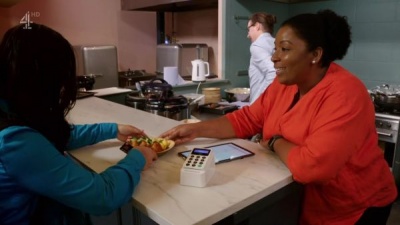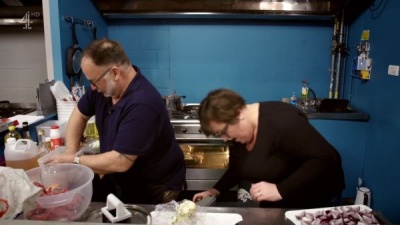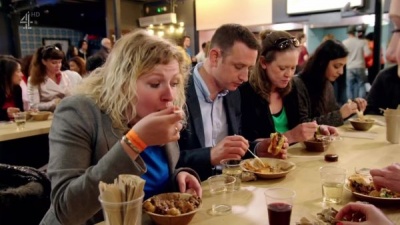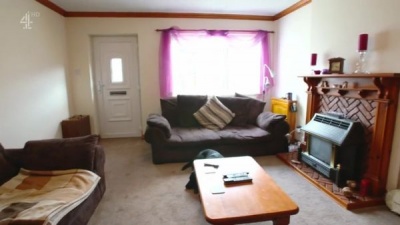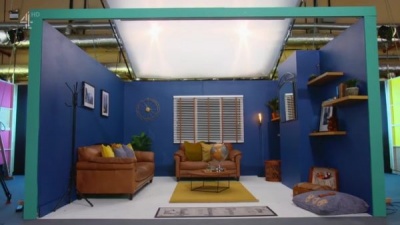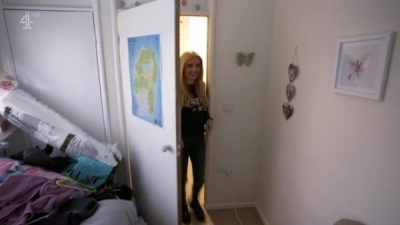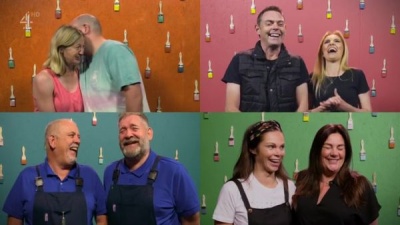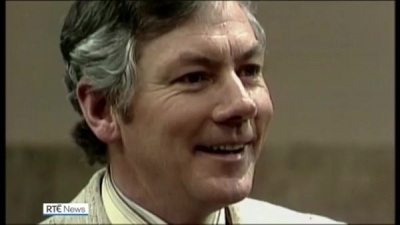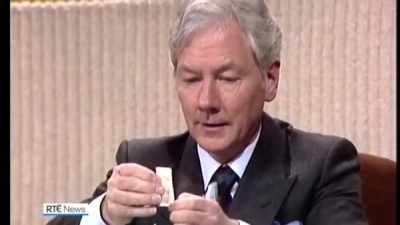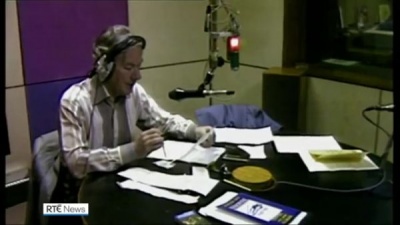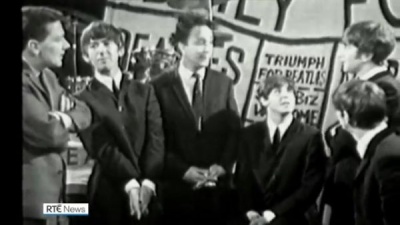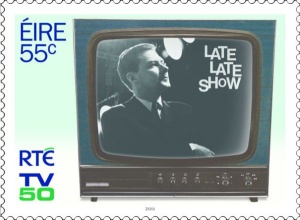Weaver's Week 2019-11-10
(Created page with 'Last week | Weaver's Week Index | Next week We said elsewhere that we planned to review ITV2's ''Kill…')
Newer edit →
Revision as of 12:05, 10 November 2019
Last week | Weaver's Week Index | Next week
We said elsewhere that we planned to review ITV2's Killer Camp this week. It would be too much of a crashing gear change to put that review next to an obituary of Gay Byrne, so we'll hold off for one week.
Instead, a couple of shows from Channel 4's Cursed 5 O'Clock Slot. Neither is as good as Five Minutes to a Fortune.
Contents |
Cooking Up a Fortune
Freida.tv for Channel 4, 9 September – 4 October
The title pretty much sums up the show. Three pairs of contestants are taken to a "food market". They'll make their best dishes, and sell at a profit. The heats last two days. On the second day, the teams repeat their first dish and add a second. There are also two rounds of selling. For the Friday final, there are three dishes to make.
How is this a contest? The costs of the ingredients are taken into account, along with the revenue, and it's that net profit that counts. (Heat for the cookers, the time in preparing the dishes, the hustle of selling them – none of that is considered. Just the input of food, and the output.) The most profitable team from each heat comes back for the Friday final. Shades of another show we don't talk about.
The format isn't entirely original – Cook Me the Money on ITV was also a pop-up street food competition, judged by net profit. But that 2013 show had entirely self-contained episodes, and Cooking Up a Fortune is a serial told across a week. There's a good balance between getting to know the teams and seeing them cook their dishes. We spend quite a lot of time with each pair, and they're colour-coded to help us see who we're watching at a glance.
This column really appreciates a brisk half-hour show. So do the viewers: the human brain appears wired to sit and listen for about 20 minutes, and to follow no more than three ideas during that span. There need to be little peaks of drama, roughly every five to seven minutes.
Cooking Up a Fortune follows this formula almost to the letter. We set up the show, then see the teams start to cook. There are only three teams, so we're not overloaded with too many overlapping plots. After about six minutes, the teams start to serve samples of their food; there's a change of pace, something to grab attention.
The half-way break falls naturally after the first serving of food. Then we have the second serving, similar to the first. Then, with a few minutes left, the debrief – what the diners thought, what the judges thought, and ultimately what the numbers say. It's a perfect example of how to structure a programme, and the 30 minute slot means we don't have any time to waste.
(A brief digression, if we may: if the human brain can concentrate for about 20 minutes, we naturally want to take advert breaks about every 20 minutes. Two breaks in an hour-long show was the regulator's requirement until the year 2000, when they allowed three ad breaks. That left programmes with shorter chunks, they were too bitty, with too many stops and starts. Fewer but longer breaks would be preferable. It's clear that successive regulators ITC and OFCOM don't understand basic human psychology, amongst many other things.)
Behind the scenes, Cooking Up a Fortune is almost an authored show. Dominic Cools-Lartigue has made his career out of "street food arenas" – pop-up kitchens in a converted warehouse or disused office block, selling food made on the premises. The show is filmed at his Street Feast location. He attracts a youthful crowd, many of the customers are millennial or younger. Our contenders are in a very small kitchen, and there's never enough time to do everything – both of these facts are made clear on the screen without ever being rubbed in.
Being cynical, we can see that Dominic Cools-Lartigue has a stake in the success of this show – the prize is an investment from him, space at one of his own street food events. This perhaps explains why they've used "profit" rather than "best dish" – his own taste might not be what brings in the crowds. And to be ultra-picky, the sound balance in some shows is variable, with quiet bits and loud bits. The narration by Penny Layden is like captions in the comics, bridging material to take us from scene to scene, aided by a jazzy and upbeat soundtrack.
Overall, it's a positive programme, shows what people can do. We get to know the teams enough to root for them, and can identify in some way with the teams. Competition is fierce but fair and friendly, and the reveal is not drawn out unnaturally. We enjoyed the sample week we saw, and wouldn't say no to more.
Your Room or Mine?
Gobstopper in association with Hillary's for Channel 4, 7 October – 1 November
If Cooking Up a Fortune was subtle in its art and in its commercial end, Your Room or Mine? is brazen. From the outset, we can see there's going to be product placement – from Hillary's, which apparently is a furniture store. Don't recall seeing it down out local high street, so it can't be a national chain. Local chain, national sponsorship: weird.
There is a contest. Across the week, four rival teams will each pick one room in their house they want to renovate. They work out the budget, and give the other teams some advance notice of what they want from the room. At this point, most interior designers would whip out their sketchpad, or their digital design program, and make an illustration of the room. See what you could have: a sofa here, walls in this and this colour, with a feature like this just here.
But this isn't going to make good television. Why just design the things on paper, when you could look at them in real life! The teams will construct a real-life replica of the room, to the actual dimensions. They'll use real paint, real carpet, real decorations, and real furniture provided by Hillary's.
As it's competition television in the twenty-first century, there's going to be an artificial deadline to force drama: in this case, five hours to paint and build and move in the furniture. At the end of the time, the teams discuss and critique each other's work, and one of the rooms is installed. The designers of that room get a fee of £250. Rinse, repeat, over four days.
Quadruple Points Friday is a feature of Your Room or Mine?. It's like Richard Osman's Double Points Friday, but they've doubled up on the doubling. All four teams are in play, and they're designing different rooms in one client's house. £1000 to the winning couple. Because the show features rooms in the same house, there's a point just before the reveal that is – literally – People Walking Through a Door. Don't do a celebrity version, Brig Bother owns the rights to that format point.
The show is narrated by Fiona Clarke in a gentle northern accent. Her script is snarky, in the Dave Lamb style – it answers back to the contestants, and completes their jokes. The narrator is an extra participant in the show, unlike the factual points on Cooking Up a Fortune.
As we'd expect, the teams go off into confessional booths. Are these recorded during the build? Afterwards? Who cares. Everything is colour-coded for our convenience, the same shade appears behind a team all week, and the same colours are around the edges of the rooms.
All of this is entirely derivative, we've seen all of these elements before. We've even seen the show's clock before. First 5 minutes: meet the teams and the room. Next 5 minutes: reveal the outline ideas, and get starting. Ad break. Next 5 minutes: finish building. Then the designs are explored, discussed. Finish with a reveal of which design's been implemented. We said earlier that "we need little peaks of drama, roughly every five to seven minutes". Treat that as a guide: let us calibrate our sundial by these little peaks, do not have them appearing as regularly as clockwork.
While this column warmed to the contestants, enough to watch a full week's episodes, we don't expect to do that again. We didn't find the show compelling, nor did it awaken our untapped interest in full-size makeovers. That said, there could well be an audience for this sort of show – there aren't many interior design shows on telly at all, and even fewer at 5.30.
Gay Byrne
'Gently touched the lives of generations'
The undisputed king of broadcasting on RTÉ died this week, aged 85. His career on radio and television made him an inquisitor, a showman, and the one person in modern Ireland who helped the Irish talk and listen to themselves.
Gabriel Mary Byrne was born in Dublin in August 1934 to Edward and Annie Byrne, the youngest of five children. Educated by the Christian Brothers in Synge Street, the death of his father prevented him from taking up a place at Trinity College Dublin. Instead, he took a job with the Royal Insurance Company, briefly tried to manage a cinema, then returned to insurance with the Guardian Insurance Company. He was taken on as a presenter by Radio Éireann in 1958, and wouldn't leave until the end of the century.
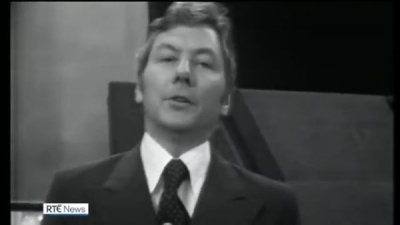 Gay Byrne occupied a very special place in the hearts and minds of Irish households – his voice narrated the story of the State for more than three decades
Gay Byrne occupied a very special place in the hearts and minds of Irish households – his voice narrated the story of the State for more than three decades
Management thought he was "too good" to read the news, and tried him on a summer filler television programme. The Late Late Show was – and is – a topical magazine programme. It runs for a long time – last week's edition started at 9.35, and didn't finish till midnight. All human life is on The Late Late Show, celebrity interviews, performances from leading musical acts, panels on the most controversial problems of the day, and gentle chats with the audience where regular people, viewers like us, could open up.
To be in a nation's front rooms every week is an honour. You become part of the furniture, indistinguishable from the dining table or the well-worn sofa. People are comfortable around you, they associate you with their own home, with friends and safety and security. And that allowed Gay Byrne to talk about topics where no-one else could possibly go. His show was able to reflect life as it really was, not how the power-brokers in Ireland wanted to think it was.
Was it important to learn the Irish language, as the government believed in the 1960s? Was it right to put unmarried mothers in a "mother and baby home", as was the practice into the 1970s? Gay Byrne would talk with people who wanted to shake off this extreme hierarchy, he let the people work out their problems amongst themselves. It's a form of deliberative democracy, mediated through a television show that everyone knows about, and almost everybody watches. In his own life, Gay Byrne was small-c conservative; by allowing other people to follow their path he was small-l liberal.
Gay Byrne wasn't just about television. He hosted The Gay Byrne Show on Radio 1, a weekday morning show from 1972 until 1998. It was the first time an Irish programme had asked listeners to ring in and talk. Gay appeared in the living room every weekend, and in the kitchen every morning, and the listeners knew him.
So close was his rapport with his listeners that they trusted him with secrets they would not share with their friends or family. He received letters telling heartbreaking stories. Byrne would read such tales without undue theatrics, succeeding where Simon Bates' Our Tune failed. In 1984, he famously devoted an entire programme to reading out letters from women moved by the tragic case of Ann Lovett, the Longford schoolgirl who died while secretly giving birth in a Granard grotto.
Highlights of The Late Late Show were shown on Channel 4 in the early 90s, usually the celebrity acts and some of the less parochial interviews. The series captured two moments of particular import. First was the occasion in 1992 when Peter Brooke, the Westminster government's minister for Northern Ireland, gave an interview, and then joined in with a few traditional songs. He was criticised by killjoys in the North for daring to have fun. A year or so later, The Late Late Show gave footage of Louis Walsh's new project, oiled-up hunks dancing to a Eurodisco number. Within a year, the successful parts of Boyzone would be household names.
Gay Byrne worked hard. He commuted in the late 1950s between Dublin and Manchester, where he worked for Granada on shows such as Pick the Winner and That's What You Think!. (From such thin connections do we claim Gay Byrne as on-topic for this column.) After he left The Late Late Show in 1999, Gay Byrne hosted RTÉ's Who Wants to be a Millionaire with his usual suave charm. Later series included Make 'Em Laugh about the history of comedy, interviews on The Meaning of Life, and The Gay Byrne Music Show for Lyric FM.
Diagnosed with prostate cancer in 2016, Gay Byrne was open about his chemotherapy treatment. He died of complications of the disease last Monday, aged 85. Gay Byrne is survived by his wife, Kathleen Watkins, and their two daughters, Crona and Suzy.
This Week and Next
Rose d'Or award nominees are out. There's no specific Game Show category any more, our shows are split across two categories:
Entertainment, where The Circle (C4) goes up against Blackout (SVT1). Other nominees you might recognise are 63 Up (ITV), Our Dementia Choir (BBC1), and The Repair Shop (BBC2 / RTL4).
Studio Entertainment, where our game shows are Holey Moley (ABC-Disney), Dance Revolution (TVA in Québec), and Songland (NBC). Others in the category include Michael McIntyre's Big Show (BBC1), and The Last Leg (C4).
The awards will be handed out by Lenny Henry on 1 December.
There was a flurry of publicity as steaming service Project Kangaroo launched. They're calling it "britbox" these days, but whatevs. Six quid a month for unlimited* archive material. Anything in the game show category? Love Island, QI XL, Have I Got News for You, Mock the Week are all there. And, er, that's it. No sign of The Adventure Game, a complete lack of Turnabout, and not a single one of the 7200 Countdown episodes. Completely scuttled our plans to settle down for a Boxing Day Box Clever box set.
BARB ratings in the week to 27 October
- Strictly Come Dancing remains television's number one show, pulling 10.7m viewers (BBC1, Sat). Bake Off is next in line (C4, Tue, 9.35m). Beneath that are David Attenburgh's new nature show Seven Worlds, One Planet (BBC1, Sun, 8.4m) and an unexpected revival of Mark Pougatch's The World Cup: NZ Rugby versus England Rugby (ITV, Sat, 7.9m).
- Would I Lie to You? did great business this week (BBC1, Fri, 4.55m), ahead of The X Factor Colon Celebrity (ITV, Sat, 4.45m). Pointless Celebrities (BBC1, Sat, 4.1m) and The Chase (ITV, Mon, 4m) both finished ahead of The Wall (BBC1, Sat, 3.9m).
- Celebrity Hunted continued on Channel 4 (Sun, 2.5m). Only Connect (BBC2, Mon, 2.4m) continued to beat University Challenge (2.35m) by a whisker; both were well ahead of Take Me Out (ITV, Sat, 2.05m). Best figures ever for Richard Osman and House of Games (3) (BBC2, Fri, 1.45m).
- On the non-public service channels, Taskmaster is still the top game (Dave, Wed, 1.15m). Celebrity Juice (ITV, Thu, 750,000) and QI XL (Dave, Mon, 350,000) follow next. Killer Camp launched to 235,000 (ITV2, Sun), level with the Masterchef Down Under final (W, Tue). MTV's True Love or True Lies? had its first week (best on Thu, 134,000).
While The Chase takes time off, Cash Trapped fills in (ITV, weekdays). There's a new run of I'm Sorry I Haven't a Clue (Radio 4, Mon), and a second series of Celebrity Countdown (More4, Tue). The Hit List returns for a second series next Saturday evening, we hope they've sorted out the graphics.
It's Children in Need week, the Friday telethon (BBC1) contains more game show elements than usual. At 10, they all nip out to a fancy restaurant, the result is Dragons' Den Does I'll Get This (BBC2).
Photo credits: Freida.tv, Gobstopper, RTÉ, Granada, An Post.


